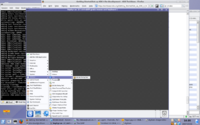Archive:Getting Started/Run/Nested Session
Getting_Started/Run/Nested_Session
Languages: عربي | Asturianu | Català | Česky | Kaszëbsczi | Dansk | Deutsch | English | Esperanto | Español | Eesti | فارسی | Suomi | Français | Galego | Italiano | 日本語 | 한국어 | Norwegian | Polski | Português Brasileiro | Română | Русский | Svenska | Slovenčina | Slovenščina | српски | Türkçe | Tiếng Việt | Українська | 简体中文 | 繁體中文
Nested KDE 4 Session
 |
Instead of using a full-blown new virtual X for developing software you can use Xephyr to embed your KDE 4 session into your working KDE 3 or other X11 environment.
You can also do this with xnest, but as xnest cannot handle extensions like Render many people prefer Xephyr.
If you want to get a minimal KDE session up and running, just launch Xephyr (available in Kubuntu as xserver-xephyr; Gentoo users compile x11-base/xorg-server with USE="kdrive"):
Xephyr :1 -extension GLX &
You can now launch KDE:
su - $USER
export DISPLAY=:1
/path/to/kde4/bin/startkde-modified &
startkde-modified is a copy of the startkde-script which includes the following lines on the top:
export KDEDIR=`kde4-config --prefix`
export LD_LIBRARY_PATH=$KDEDIR/lib
export PATH=$KDEDIR/bin/:$PATH
export KDEHOME=~/.kde4
You can also use Xephyr with KDM via the Xdmcp protocol and simply a new KDE 4 session to KDM.
On Kubuntu, you can enable it by changing
[Xdmcp]
- Whether KDM should listen to incoming XDMCP requests.
- Default is true
Enable=false
in /etc/kde3/kdm/kdmrc to
[Xdmcp]
- Whether KDM should listen to incoming XDMCP requests.
- Default is true
Enable=true
and adjust your /etc/kde3/kdm/Xaccess to allow your local machine access. Additionally you should make sure to set up a port blocking policy on all external interfaces for the Xdmcp port if you are doing this on a laptop or a PC in an untrusted environment.
If you are done, simply launch Xephyr:
Xephyr -query localhost :1 -host-cursor -screen 1024x768&
where -host-cursor tries to reuse the host's cursor and -screen sets the screen dimensions.
Xephyr -ac :1&
Another option to try if you get lots of refused connection errors is you may need to grant assess to your kde-devel user to your X server. As root or using sudo execute:
xhost +local:kde-devel
If you do not have Xephyr, you can also use Xnest:
Xnest -ac :1& export DISPLAY=:1
cleanup confusing sections and fix sections which contain a todo
Sping 00:25, 9 April 2007 (CEST)
I use this for my start script nested_kde4.sh:
#! /bin/bash
NESTED_KDE_DISPLAY_BACKUP=$DISPLAY
export DISPLAY=:0
Xephyr :1 -screen 1024x768 &
export DISPLAY=:1
$HOME/kde/bin/startkde-modified &
export DISPLAY=${NESTED_KDE_DISPLAY_BACKUP}
If you run into
"Call to lnusertemp failed (temporary directories full?). Check your installation."
try this:
mkdir /var/tmp/kde-devel-kde4
The above code assumes you work with user kde-devel.
